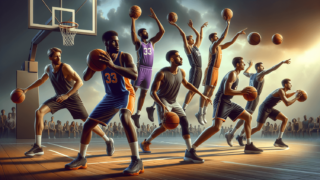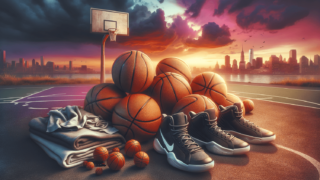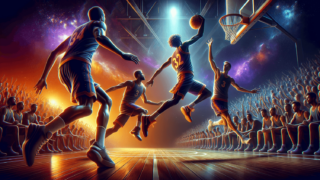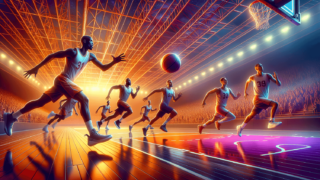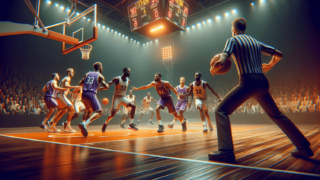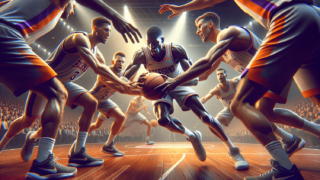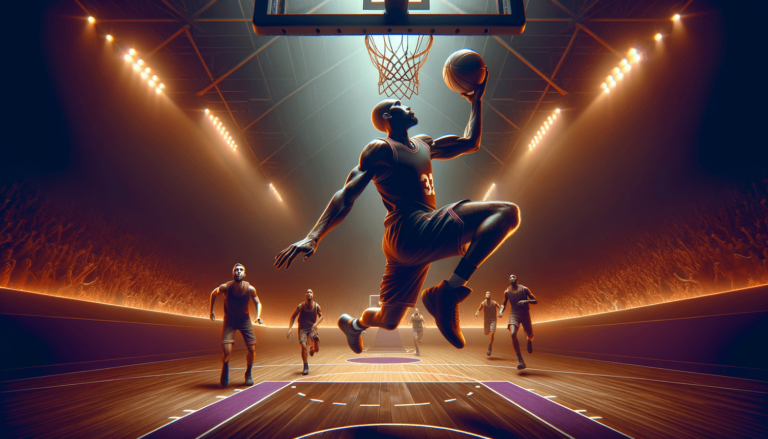
If you’ve ever watched a basketball game, you’ve probably heard the word “boards” being thrown around by commentators and fans alike. But what exactly are boards in basketball, and why are they such a pivotal part of the game? In this fun and comprehensive blog post, we’ll dive into the world of boards, revealing not only what they are but also unveiling their importance in both individual and team success. So, grab your sneakers and get ready to explore an often-overlooked yet crucial aspect of the game that keeps fans on the edge of their seats!
What Are Boards in Basketball?
Boards in basketball, also known as rebounds, are the act of gaining possession of the ball after a missed shot. Rebounds are essential because they can provide a team with additional scoring opportunities and help prevent opponents from scoring. Boards are typically accumulated by players who excel in positioning, strength, and anticipation, and are often classified as either offensive or defensive rebounds, depending on which team regains possession.
Understanding the Importance of Rebounds in Basketball
One of the essential aspects of basketball is mastering the art of rebounding. Rebounds or ‘boards’ directly impact a team’s scoring opportunities and can determine the result of a game. A defensive rebound prevents the opposition from getting another chance to score, while an offensive rebound gives the team an additional opportunity to put points on the board. This makes rebounds a valuable skill to have and a critical aspect to understand for both players and fans of the game. In this in-depth and engaging exploration of boards in basketball, we’ll examine the nuances and strategies behind rebounding, along with tips to help you improve this vital aspect of the game.
Offensive and Defensive Rebounds: Securing Possession
Defining Offensive and Defensive Rebounds
Rebounds in basketball are categorized into two types: offensive and defensive rebounds. Both types of rebounds are essential in determining a team’s success, but they differ in terms of their implications on the game.
An offensive rebound occurs when a player from the team that has attempted a shot recovers the ball after the shot misses the target. This grants the team another possession and an opportunity for a second-chance shot. Conversely, a defensive rebound is when a player from the defending team retrieves the ball after the opponents miss a shot. This ends the opponents’ offensive possession and allows the defending team to transition into offense.
Impact of Offensive and Defensive Rebounds on the Game
The value of offensive rebounds is evident in their ability to give a team additional chances to score. They not only extend a team’s possession but also demoralize the opposition by turning their successful defense into a wasted effort. Effective offensive rebounding can significantly increase a team’s chances of winning over a team that wins on pure shooting prowess.
Defensive rebounds, although less flashy, are equally important in ensuring a team’s success. Controlling defensive boards helps limit the opposition’s scoring chances, keeping their score low while bringing the ball back to the offensive end. A strong defensive rebounding team directly affects their opponent’s morale, especially when they consistently deny second-chance scoring opportunities.
Tactics and Techniques for Securing Boards
Boxing Out: The Key to Dominating the Boards
Boxing out is a fundamental technique that every basketball player, regardless of position or size, should learn and master. Fundamentally, boxing-out entails placing one’s body between an opponent and the basket, thus denying them access to potentially grab a rebound. Players should bend their knees and maintain a wide stance, keeping their arms out to the side as they use their hips and legs to block out opponents, effectively clearing the area for the rebound.
Anticipating Shot Trajectory
Rebounding is as much about anticipation and understanding shot trajectory as it is about positioning and strength. Being able to read where a missed shot will likely end up is crucial to securing rebounds. Generally speaking, long shots such as three-pointers tend to result in long rebounds, while shorter shots often result in shorter rebounds. Understanding this can help players position themselves more effectively when anticipating rebounds.
Using Vertical Superiority
Height and athleticism play a significant role in the ability to grab boards. Although not every player can be blessed with a towering height, focusing on developing one’s vertical leap and timing can improve the chances of snagging a rebound. For those who lack the height or jumping ability, effective boxing out and playing with high energy can still make them successful rebounders.
Rebounding Drills to Elevate Your Game
The Mikan Drill
Named after basketball legend George Mikan, the Mikan Drill is a classic basketball drill designed to develop rebounding and finishing abilities. The drill involves standing under the basket, then repeatedly shooting layups from alternating sides without allowing the ball to touch the ground, as you secure every rebound. Practicing the Mikan Drill helps develop rebounding instincts, soft touch around the rim, and the essential skill of finishing after grabbing a rebound.
The Superman Drill
The Superman Drill focuses on developing strength and explosiveness while also refining rebounding fundamentals. To perform the Superman Drill, a player lies face-down, fully extended on the court with their arms stretched above their head to mimic the flying pose of the superhero. Upon the coach’s or partner’s signal, the player quickly jumps to their feet, sprints to the basket, and explodes vertically to secure a rebound thrown by the coach. The Superman Drill builds the strength, explosiveness, and speed required to out-jump opponents and secure rebounds effectively.
Rebound, Outlet, and Transition Drill
This multi-faceted drill practices not only securing defensive rebounds but also helps improve the subsequent offensive transition process. A coach or trainer will shoot the ball, and the player attempts to secure the rebound. Once the player successfully grabs the rebound, they immediately make a proper outlet pass to a teammate or coach, who will then throw a pass down the court. The player who initiated the outlet pass will then sprint down the court to receive the pass for a layup or jump shot. This drill is an excellent way to combine rebounding, passing, and conditioning into one exercise.
Notable Rebounding Legends in Basketball History
Bill Russell
As a staple figure in the annals of basketball history, Bill Russell is known for his legendary shot-blocking and impressive rebounding skills. The 11-time NBA champion played a crucial role in defining the center position, embodying the importance of defense and rebounding. Russell’s tenacious work ethic and unyielding focus on securing boards contributed to his status as one of the most formidable rebounders who ever played the game.
Wilt Chamberlain
Another iconic basketball figure, Wilt Chamberlain, was a dominant force during his time in the NBA, amassing numerous scoring and rebounding records. Standing at a staggering 7’1″, Chamberlain led the league in rebounding 11 times and maintains the highest career rebounds per game average in NBA history. His overwhelming size, athleticism, and relentless pursuit of the ball made him an unmatched presence on the boards.
Dennis Rodman
While lacking the towering height of Russell and Chamberlain, Dennis Rodman carved out his place in history as a relentless rebounding machine. Known for his tenacity and instinct, the 6’7″ forward consistently out-rebounded much taller opponents by perfecting the art of boxing out, anticipating shot trajectories, and playing with unwavering energy. Rodman’s 7-time All-Defensive First Team selections and two Defensive Player of the Year awards showcase his prowess as a defensive and rebounding legend.
Conclusion
Boards, or rebounds, form a significant aspect of basketball, often determining the flow and outcome of a game. By understanding their importance, mastering techniques, and learning strategies to gain and maintain possession through offensive and defensive rebounds, a player can contribute significantly to their team’s success. Embrace the challenge of improving your rebounding skills, and remember that dominating the boards can elevate a team from merely good to truly great.
The Impact of Rebounding on Game Analytics
As basketball analytics have become an increasingly prevalent aspect of evaluating team performance, the role of rebounding in determining a team’s overall efficiency has become more evident. Advanced statistics such as rebounding percentage, contested rebound percentage, and rebound chances per game can offer insights into both team and individual rebounding prowess. By examining these metrics, players and coaches can better understand the importance of boards in basketball and make adjustments to their play style to achieve optimal efficiency.
Crucial Factors in Becoming an Effective Rebounder
Strength and Conditioning
Physical strength plays a significant role in an individual’s ability to compete for rebounds effectively. A strong foundation of core, leg, and upper body strength helps a player maintain position while boxing out and to power through contact during the rebounding process. To improve their strength, players should engage in a comprehensive strength and conditioning program that focuses on developing functional strength tailored to basketball-specific movements.
Basketball IQ and Court Awareness
Basketball IQ is often overlooked when discussing rebounding, but it plays a significant role in generating success in this area. Understanding teammates’ shooting tendencies, knowing when and where shots are likely to be released, and being aware of opponents’ positioning on the floor can contribute significantly to one’s rebounding ability. By cultivating a deeper understanding of the game and remaining aware of the court’s dynamics, a player can put themselves in an advantageous position to secure boards effectively.
Effort and Persistence
Rebounding is, in large part, a skill that rewards maximum effort and persistence. Players who are consistently aggressive in pursuing loose balls, relentless in boxing out opponents, and unwavering in their determination to win rebounds will often find success. Maintaining a high level of energy throughout the game is crucial, and it is essential for players to maintain a never-give-up attitude when pursuing boards.
The Role of Big Men and Guards in Rebounding
Big Men and Dominating the Paint
Centers and power forwards, often referred to as ‘big men,’ typically shoulder the responsibility of securing rebounds due to their inherent size advantage. Dominating the paint and controlling the boards is a central part of any big man’s job description. Rebounding aptitude is usually even more critical for these players, as it allows them to maximize their physical attributes and contribute meaningfully to their team’s success.
Guards and Their Contrasting Rebounding Strategies
While guards may not appear to play as prominent a role in rebounding as big men, their contributions in this aspect should not be overlooked. Many guards, particularly those with above-average size and athleticism, have demonstrated impressive rebounding abilities throughout the history of the game. These players use their quickness and court awareness to find open lanes to the ball and secure rebounds that usually belong to the big men.
Smaller guards, on the other hand, often focus on boxing out or ‘checking’ their man to prevent their opponents from securing offensive rebounds. Another crucial task for guards is to retreat back to the defensive end after the shot to cover fast breaks, allowing their teammates to close out and secure the rebounds more effectively.
Boards – The Invisible Stat
Rebounds often fly under the radar in comparison to flashy scoring, assists, or blocks, but their importance in influencing the flow and outcome of a basketball game is undeniable. By dissecting boards in basketball more closely, players, coaches, and fans alike can foster a deeper appreciation for this sometimes-overlooked skill. Consistently securing rebounds can create game-changers, and in many cases, grabbing that last board may be the difference between victory and defeat.
Frequently Asked Questions
Now that we’ve explored the world of basketball boards, we understand that there are often questions related to this crucial aspect of the game. To tighten your grasp on this topic, we’ve provided a list of frequently asked questions, from the basic to the nuanced, and answered them in an easy-to-understand manner. Let’s dive into these FAQs to help you gain a well-rounded perspective of basketball rebounds.
What’s the difference between offensive and defensive boards?
An offensive board is when a player on the team that took the shot recovers the ball after a missed attempt. A defensive board is when a player on the defending team retrieves the ball after the opponents’ missed shot. Offensive boards provide second-chance scoring opportunities, while defensive boards help secure possession so the team can transition into offense.
Why are rebounds important in basketball?
Rebounds are essential as they can impact a team’s scoring opportunities and potentially determine the game’s outcome. They maintain or gain possession for a team, allowing for additional scoring chances (offensive) or shutting down opponents’ scoring opportunities (defensive).
What are the key techniques for effective rebounding?
Some key techniques for effective rebounding are boxing out, anticipating shot trajectory, utilizing vertical superiority, and continuous effort and persistence in pursuing the ball.
What is boxing out, and how can players improve this skill?
Boxing out involves placing one’s body between an opponent and the basket, denying them access to potentially grab a rebound. Players should bend their knees, maintain a wide stance, and use their hips and legs to block out opponents. Practicing boxing out during drills and game situations can improve this skill.
How can a player improve their rebounding abilities?
Improving rebounding abilities involves a combination of factors, such as developing physical strength, basketball IQ, and court awareness, and consistently giving maximum effort and persistence during games and practices.
How can guards contribute to rebounding?
Guards can contribute to rebounding by boxing out or “checking” their man to prevent their opponents from securing offensive rebounds. They can also retreat back to the defensive end to cover fast breaks, securing long rebounds using their quickness and anticipation, or supporting their big men in securing boards.
Do taller players have an advantage in rebounding?
While taller players generally have an advantage in rebounding because of their height, they still need to possess good positioning, anticipation skills, and physical strength. Shorter players can find success on the boards through excellent boxing-out techniques and high-energy play.
What are some popular rebounding drills?
Popular rebounding drills include the Mikan Drill, the Superman Drill, and the Rebound, Outlet, and Transition Drill. These drills focus on developing rebounding instincts, strength, explosiveness, and transitioning effectively after securing boards.
Can advanced statistics help evaluate a player’s rebounding ability?
Yes, advanced statistics like rebounding percentage, contested rebound percentage, and rebound chances per game can help evaluate a player’s rebounding ability and provide insights into a team’s overall efficiency in this aspect.
What is the role of big men in rebounding?
Centers and power forwards, or “big men,” typically have the responsibility of securing rebounds due to their inherent size advantage. Controlling the boards and dominating the paint is a crucial part of a big man’s role on the team.
Who are some notable rebounders in basketball history?
Some of the most notable rebounders in basketball history include Bill Russell, Wilt Chamberlain, and Dennis Rodman. These players were dominant in their respective eras and showcased exceptional skills and tenacity on the boards.
Why are some players more successful at grabbing rebounds than others?
Some players are more successful at grabbing rebounds due to factors such as physical strength, height, athleticism, basketball IQ, court awareness, anticipation skills, boxing-out techniques, and their commitment to consistent effort and persistence on the court.
Featured Posts
- No pillar pages found.
